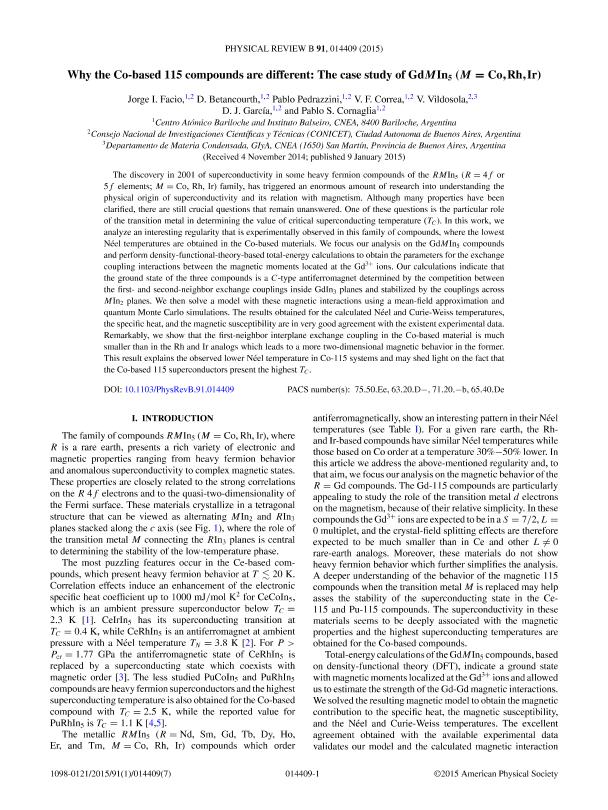Mostrar el registro sencillo del ítem
dc.contributor.author
Facio, Jorge Ismael

dc.contributor.author
Betancourth Giraldo, Diana Maria

dc.contributor.author
Pedrazzini, Pablo

dc.contributor.author
Correa, Víctor Félix

dc.contributor.author
Vildosola, Veronica Laura

dc.contributor.author
Garcia, Daniel Julio

dc.contributor.author
Cornaglia de la Cruz, Pablo Sebastian

dc.date.available
2020-08-25T14:48:24Z
dc.date.issued
2015-01
dc.identifier.citation
Facio, Jorge Ismael; Betancourth Giraldo, Diana Maria; Pedrazzini, Pablo; Correa, Víctor Félix; Vildosola, Veronica Laura; et al.; Why the Co-based 115 compounds are different: The case study of GdM In5 (M=Co,Rh,Ir); American Physical Society; Physical Review B: Condensed Matter and Materials Physics; 91; 1-2015; 144091-144097
dc.identifier.issn
1098-0121
dc.identifier.uri
http://hdl.handle.net/11336/112306
dc.description.abstract
The discovery in 2001 of superconductivity in some heavy fermion compounds of the RMIn5 (R=4f or 5f elements; M=Co, Rh, Ir) family, has triggered an enormous amount of research into understanding the physical origin of superconductivity and its relation with magnetism. Although many properties have been clarified, there are still crucial questions that remain unanswered. One of these questions is the particular role of the transition metal in determining the value of critical superconducting temperature (TC). In this work, we analyze an interesting regularity that is experimentally observed in this family of compounds, where the lowest Néel temperatures are obtained in the Co-based materials. We focus our analysis on the GdMIn5 compounds and perform density-functional-theory-based total-energy calculations to obtain the parameters for the exchange coupling interactions between the magnetic moments located at the Gd3+ ions. Our calculations indicate that the ground state of the three compounds is a C-type antiferromagnet determined by the competition between the first- and second-neighbor exchange couplings inside GdIn3 planes and stabilized by the couplings across MIn2 planes. We then solve a model with these magnetic interactions using a mean-field approximation and quantum Monte Carlo simulations. The results obtained for the calculated Néel and Curie-Weiss temperatures, the specific heat, and the magnetic susceptibility are in very good agreement with the existent experimental data. Remarkably, we show that the first-neighbor interplane exchange coupling in the Co-based material is much smaller than in the Rh and Ir analogs which leads to a more two-dimensional magnetic behavior in the former. This result explains the observed lower Néel temperature in Co-115 systems and may shed light on the fact that the Co-based 115 superconductors present the highest TC.
dc.format
application/pdf
dc.language.iso
eng
dc.publisher
American Physical Society

dc.rights
info:eu-repo/semantics/openAccess
dc.rights.uri
https://creativecommons.org/licenses/by-nc-sa/2.5/ar/
dc.subject
ANTIFERROMAGNETICS
dc.subject
PHONON STATES AND BANDS, NORMAL MODES, AND PHONON DISPERSION
dc.subject
ELECTRON DENSITY OF STATES AND BAND STRUCTURE OF CRYSTALLINE SOLIDS
dc.subject
THERMAL EXPANSION; THERMOMECHANICAL EFFECTS
dc.subject.classification
Física de los Materiales Condensados

dc.subject.classification
Ciencias Físicas

dc.subject.classification
CIENCIAS NATURALES Y EXACTAS

dc.title
Why the Co-based 115 compounds are different: The case study of GdM In5 (M=Co,Rh,Ir)
dc.type
info:eu-repo/semantics/article
dc.type
info:ar-repo/semantics/artículo
dc.type
info:eu-repo/semantics/publishedVersion
dc.date.updated
2020-06-18T15:10:50Z
dc.journal.volume
91
dc.journal.pagination
144091-144097
dc.journal.pais
Estados Unidos

dc.journal.ciudad
New York
dc.description.fil
Fil: Facio, Jorge Ismael. Comisión Nacional de Energía Atómica. Gerencia del Área de Energía Nuclear. Instituto Balseiro; Argentina. Comisión Nacional de Energía Atómica. Centro Atómico Bariloche; Argentina. Consejo Nacional de Investigaciones Científicas y Técnicas. Centro Científico Tecnológico Conicet - Patagonia Norte; Argentina
dc.description.fil
Fil: Betancourth Giraldo, Diana Maria. Comisión Nacional de Energía Atómica. Centro Atómico Bariloche; Argentina. Comisión Nacional de Energía Atómica. Gerencia del Área de Energía Nuclear. Instituto Balseiro; Argentina. Consejo Nacional de Investigaciones Científicas y Técnicas. Centro Científico Tecnológico Conicet - Patagonia Norte; Argentina
dc.description.fil
Fil: Pedrazzini, Pablo. Comisión Nacional de Energía Atómica. Centro Atómico Bariloche; Argentina. Consejo Nacional de Investigaciones Científicas y Técnicas. Centro Científico Tecnológico Conicet - Patagonia Norte; Argentina. Comisión Nacional de Energía Atómica. Gerencia del Área de Energía Nuclear. Instituto Balseiro; Argentina
dc.description.fil
Fil: Correa, Víctor Félix. Comisión Nacional de Energía Atómica. Gerencia del Área de Energía Nuclear. Instituto Balseiro; Argentina. Comisión Nacional de Energía Atómica. Centro Atómico Bariloche; Argentina. Consejo Nacional de Investigaciones Científicas y Técnicas. Centro Científico Tecnológico Conicet - Patagonia Norte; Argentina
dc.description.fil
Fil: Vildosola, Veronica Laura. Comisión Nacional de Energía Atómica; Argentina. Consejo Nacional de Investigaciones Científicas y Técnicas; Argentina
dc.description.fil
Fil: Garcia, Daniel Julio. Comisión Nacional de Energía Atómica. Gerencia del Área de Energía Nuclear. Instituto Balseiro; Argentina. Comisión Nacional de Energía Atómica. Centro Atómico Bariloche; Argentina. Consejo Nacional de Investigaciones Científicas y Técnicas. Centro Científico Tecnológico Conicet - Patagonia Norte; Argentina
dc.description.fil
Fil: Cornaglia de la Cruz, Pablo Sebastian. Comisión Nacional de Energía Atómica. Centro Atómico Bariloche; Argentina. Consejo Nacional de Investigaciones Científicas y Técnicas. Centro Científico Tecnológico Conicet - Patagonia Norte; Argentina. Comisión Nacional de Energía Atómica. Gerencia del Área de Energía Nuclear. Instituto Balseiro; Argentina
dc.journal.title
Physical Review B: Condensed Matter and Materials Physics

dc.relation.alternativeid
info:eu-repo/semantics/altIdentifier/url/http://journals.aps.org/prb/abstract/10.1103/PhysRevB.91.014409
dc.relation.alternativeid
info:eu-repo/semantics/altIdentifier/doi/http://dx.doi.org/10.1103/PhysRevB.91.014409
Archivos asociados
